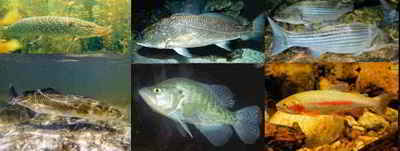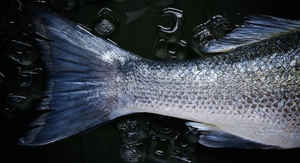
Vermont Symbols
Vermont State Coldwater Fish
Brook Trout

(Salvelinus fontinalis)
Adopted on May 3, 1978
Vermont boasts the most unusual walleye designation. When students campaigned for the adoption of the brook trout, (Salvelinus fontinalis,) the State Fish and Game Commission wanted to add the walleye because it inhabits Vermont's largest lake, Lake Champlain, which is relatively warm.
In a compromise, the brook trout was named the official cold water fish, the walleye the state warm water fish on May 3, 1978.
The Brook Trout takes first place for the most popular state fish with these states claiming it for their Official State Fish; Maine, Michigan, New Hampshire, New Jersey, New York, Pennsylvania, Vermont, Virginia, and West Virginia. Taken as a whole, trout dominate the Official State Fish category with 18 states calling some type of trout their Official State Fish.
Vermont State Coldwater Fish: Brook Trout

The cold, clear water of Vermont's lakes and streams provide excellent fishing opportunities throughout the state in a magnificent natural setting. Mountain streams are prime spots for brook, brown and rainbow trout.
Vermont has four species of trout - lake trout, brown trout, rainbow trout, and the state's signature native fish, the brook trout. Trout are considered "coldwater"fish. They can only survive and reproduce naturally in steams with cold, clean water and diverse habitat. Trout are also stocked in some of the larger streams and rivers in Vermont that become too warm in the summer to support wild trout. The best fishing for stocked trout is shortly after the fish have been stocked in May before water temperatures increase in the summer. In contrast, wild trout in Vermont's cold streams and rivers can be caught all summer long and even into the fall. Regardless of the season, trout fishing is usually best around dawn or dusk, when trout are most active.
Vermont lakes such as Champlain, Seymour, Willoughby and Caspian are renowned for their trout and landlocked salmon fishing, while rivers such the Batten Kill, Mettawee, White, and Dog deserve to be included among America's great trout streams.Characteristics of the Brook Trout
The brook trout (Salvelinus fontinalis), sometimes called the eastern brook trout, is a species of fish in the salmon family of order Salmoniformes. It is native to Eastern North America in the United States and Canada. In many parts of its range, it is known as the speckled trout or squaretail
Common Names:
Eastern Brook Trout, Brookie, Speckled Trout, Native Trout, Squaretail
Identification
Brook trout have a dark olive body with a brownish to greenish back and light worm-like markings. The sides are pale with several small blue-bordered red spots. The lower fins have dark and light edges.
Typical Adult:
Length: Up to 18 inches (sometimes up to 34 inches)
Weight: Up to 3 pounds (may reach 14 pounds)
Life span: Up to 15 years
Distribution
North America: most of eastern Canada from Newfoundland to western side of Hudson Bay; south in Atlantic, Great Lakes, and Mississippi River basins to Minnesota and northern Georgia in USA. Widely introduced in temperate regions of other continents. Several countries report adverse ecological impact after introduction.
Habitat
Brook trout live in clear and cold streams, lakes, and ponds, often with access to sea, but are mostly found in the headwaters of spring-fed streams. The preferred water temperature is 53-56 °F.
Feeding Behavior
Brook trout feed on a wide variety of aquatic insects and other invertebrates. Often they will feed on other fish and vertebrates such as salamanders, tadpoles, small snakes, and mammals that get too close or fall into the water.
Reproductive Behavior (Spawning):
When: Brook trout spawn in the fall between mid-October to early December.
Preferred Water Temperature: 40-49 Degrees F
How: Spawning takes place on the gravel-bottom areas of streams, usually near springs. Lake and pond populations spawn in shallow gravel-bottom areas near springs where there is some upwelling through the gravel. Females dig spawning pits or redds by lying on their sides and vibrating the tail rapidly. The female may be attended by several males who court her by approaching and touching her sides. When the female is ready to spawn, she moves to the bottom of the redd with the male. The male moves his body so as to hold the female in position. They vibrate together for several seconds as the female exudes her eggs and the male emits sperm. After spawning, the female will cover the nest with gravel by sweeping her tail. Spawning such as this may occur several times throughout the season by both partners. Hatching time is variable and depends on water temperatures. There is no parental care given to the eggs or hatchlings.
Adoption of the Vermont State Cold Water Fish
Joint Resolution R-91 of the Acts of 1978, effective on May 3, 1978, designated not one but two State Fishes: the Brook Trout (Salvelinus fontinalis) as the cold water fish, and the Walleye Pike (Stizosedion vitreum vitreum) as the warm water fish. Both are handsome, sporty and tasty game fish. The Brook Trout is the state's only trout native to its streams. Its mature weight varies considerably, depending on habitat in both cold brooks and ponds, but generally averages under a pound. The biggest Brook Trout caught in Vermont since official records began in 1969 weighed 5 lbs. 12 oz. The Walleye Pike, found in many Vermont lakes, takes its name from its unusual "marble" eyes which in certain light look very light or transparent. Its mature weight is four to eight pounds and the biggest one caught since 1969 weighed 12 lbs. 8 oz.
From Office of the Secretary of State, Vermont Legislative Directory and State Manual, Biennial Session, 1993-1994, p. 18.
Vermont Law
Because the brook trout was adopted by Joint Resolution, it is not listed in the Vermont Statutes alongside other symbols such as the state bird, the state flower, and the state amphibian.
Taxonomic Hierarchy: Brook Trout
Kingdom: Animalia - animals
Phylum: Chordata - chordates
Subphylum: Vertebrata
Superclass: Osteichthyes - bony fishes
Class: Actinopterygii - ray-finned and spiny rayed fishes
Order: Salmoniformes - salmon and trout
Family: Salmonidae - salmon and trout
Genus: Salvelinus --
Species: Salvelinus fontinalis







